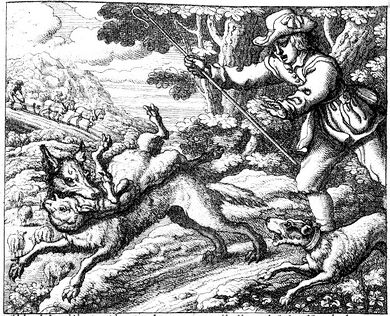الفتى الذي ادعى وجود ذئب

The Boy Who Cried Wolf is one of Aesop's Fables, numbered 210 in the Perry Index.[1] From it is derived the English idiom "to cry wolf", defined as "to give a false alarm" in Brewer's Dictionary of Phrase and Fable[2] and glossed by the Oxford English Dictionary as meaning to make false claims, with the result that subsequent true claims are disbelieved.[3]
Fable
The tale concerns a shepherd boy who repeatedly fools villagers into thinking a wolf is attacking his town's flock. When an actual wolf appears and the boy calls for help, the villagers believe that it is another false alarm, and the sheep are eaten by the wolf. In a later English-language poetic version of the fable, the wolf also eats the boy. This happens in Fables for Five Years Old [ك] (1830) by John Hookham Frere,[4] in William Ellery Leonard's Aesop & Hyssop (1912),[5] and in Louis Untermeyer's 1965 poem.[6]
The moral stated at the end of the Greek version is, "this shows how liars are rewarded: even if they tell the truth, no one believes them". It echoes a statement attributed to Aristotle by Diogenes Laërtius in his The Lives and Opinions of Eminent Philosophers, in which the sage was asked what those who tell lies gain by it and he answered "that when they speak truth they are not believed".[7] William Caxton similarly closes his version with the remark that "men bileve not lyghtly hym whiche is knowen for a lyer [ك]".[8]
History
The story dates from Classical times, but, since it was recorded only in Greek and not translated into Latin until the 15th century, it only began to gain currency after it appeared in Heinrich Steinhöwel's collection of the fables and so spread through the rest of Europe. For this reason, there was no agreed title for the story. Caxton titles it "Of the child whiche kepte the sheep [ك]" (1484), Hieronymus Osius "The boy who lied" ("De mendace puero", 1574), Francis Barlow "Of the herd boy and the farmers" ("De pastoris puero et agricolis", 1687), Roger L'Estrange "A boy and false alarms" (1692), and George Fyler Townsend "The shepherd boy and the wolf" (1867). It was under the final title that Edward Hughes set it as the first of ten Songs from Aesop's Fables for children's voices and piano, in a poetic version by Peter Westmore (1965).[9] It also features as the second of "Aesop's Fables for narrator and band" (1999) by Scott Watson (b. 1964)[10]
Teachers have used the fable as a cautionary tale about telling the truth, but an educational experiment in the first decade of the 21st century suggested that reading "The Boy Who Cried Wolf" increased children's likelihood of lying; reading about George Washington and the cherry tree, however, decreased this likelihood dramatically.[11] The suggestibility and favourable outcome of the behaviour described, therefore, seems the key to moral instruction of the young. However, when dealing with the moral behaviour of adults, Samuel Croxall asks, referencing political alarmism, "when we are alarmed with imaginary dangers in respect of the public, till the cry grows quite stale and threadbare, how can it be expected we should know when to guard ourselves against real ones?"[12]
References
- ^ "151. THE BOY WHO CRIED 'WOLF' (Laura Gibbs, translator)". mythfolklore.net.
- ^ The Concise Dictionary...(Cassel Publications 1992)
- ^ "wolf". Compact Oxford English Dictionary. askoxford.com. OUP. June 2005. Archived from the original on December 1, 2008. Retrieved 19 September 2007.
- ^ "Poem: Fable 3, Of the Boy and the Wolf by John Hookham Frere". www.poetrynook.com. Retrieved Apr 4, 2023.
- ^ "Poem: The Shepherd-Boy and the Wolf by William Ellery Leonard". www.poetrynook.com. Retrieved Apr 4, 2023.
- ^ "The Boy Who Cried Wolf" by Louis Untermeyer, raynhalfpint.wordpress.com
- ^ Translated by C. D. Yonge: Section XI (apophthegms) of the life of Aristotle Archived 2011-02-21 at the Wayback Machine
- ^ "Of the child whiche kepte the sheep [ك]" at mythfolklore.net
- ^ Songs from Aesop's Fables, details on WorldCat
- ^ performance and score
- ^ Po Bronson; Ashley Merryman (2009). Nurture Shock – New Thinking about Children. New York: Grand Central Publishing. pp. 83–84. ISBN 978-0-446-56332-1.
- ^ The Fables of Aesop, Fable CLV; available on Google Books, p. 263
External links
 Works related to The Boy Who Cried Wolf at Wikisource
Works related to The Boy Who Cried Wolf at Wikisource Media related to الفتى الذي ادعى وجود ذئب at Wikimedia Commons
Media related to الفتى الذي ادعى وجود ذئب at Wikimedia Commons- Laura Gibbs' gallery of 15th–20th century book illustrations of the fable
- Short description is different from Wikidata
- Articles with hatnote templates targeting a nonexistent page
- Articles containing لاتينية-language text
- Pages with empty portal template
- Aesop's Fables
- English-language idioms
- Fictional shepherds
- Fictional wolves
- Wolves in folklore, religion and mythology
- Big Bad Wolf
- Metaphors referring to wolves
- ATU 1200-1349